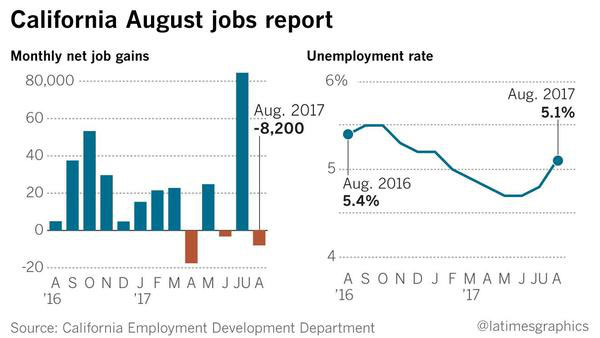[Source: Los Angeles Times] California’s slowing economic expansion was evident in August as the state lost 8,200 net jobs and the unemployment rate rose to 5.1%, from 4.8% a month earlier, according to data released Friday from the state’s Employment Development Department.
The drop in employment follows a robust July in which the Golden State gained the most jobs in more than a year: 84,500, revised up from a previous estimate of 82,600.
August’s slide back was in large part driven by employers in the leisure and hospitality sector: They cut 12,400 jobs on a seasonally adjusted basis — the largest decrease by any sector in the state.
Professional and business services and the public sector also lost jobs. Manufacturing and the trade, transportation and utilities sector, meanwhile, gained jobs.

The report is the latest topsy-turvy snapshot of the California economy, which in recent months has alternated between job gains and losses. Month-to-month jobs movements are erratic, though, and analysts caution against drawing conclusions from the data.
“This month’s job losses should not be a serious concern,” said Michael Bernick, who was director of the state Employment Development Department between 1999 and 2004. “They are important to follow, but at the same time, you want to step back.”
Indeed, the longer-term picture shows an economy that continues to expand, but is showing signs of slowing down.
Since 2012, California has tended to grow faster than the nation as a whole, in part because of solid growth in the tech sector. The state did so again in August, with jobs up 1.6% from a year earlier, compared with 1.4% nationwide.
But since January the state has added 124,600 jobs, 70,900 fewer than it did during the same period a year earlier.
Some economists have attributed the slowdown in part to the increasingly high cost of housing, which employers say has made it difficult to recruit new workers.
Low birth rates and immigration levels are also making it difficult to grow, said Robert Kleinhenz, an economist with Beacon Economics and the UC Riverside School of Business. “We are at full employment,” he said.
August’s numbers may not be as bad as they look.
For one thing, Kleinhenz said he expects the August figures to be revised upward, potentially even to an increase, given trends in major metropolitan areas like Los Angeles County. Los Angeles employers added 7,500 net new jobs last month, according to a seasonally adjusted calculation from Beacon Economics. Among the top performers was the healthcare sector, which added 5,400 jobs.
Los Angeles County unemployment rose to 4.8%, from 4.5%.
The increase in both state and regional unemployment came chiefly from a rise in the labor force, rather than job losses. Statewide, the workforce gains were the largest since 2010 as higher wages lured more people to look for a job, Kleinhenz said.
“That gives us a little bit more room to grow,” he said of rising labor force participation. “These higher underemployment rates are not a sign the economy is weakening.”
Still, it’s unclear how long the economic expansion will continue.
Bernick, who is now an attorney at the law firm Sedgwick in San Francisco, said he’s been surprised there hasn’t been more of a slowdown this year, given high housing costs and the fact that the current jobs expansion has been one of the longest since World War II.
“At some point this will end,” he said.
Source: Los Angeles Times
September 15, 2017


